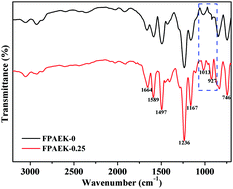Enhanced thermal stability and wettability of an electrospun fluorinated poly(aryl ether ketone) fibrous separator for lithium-ion batteries
Abstract
To improve the safety and high performance of lithium-ion batteries (LIBs), a novel and heat-resistant fluorinated poly(aryl ether ketone) (FPAEK) compound was successfully synthesized and further fabricated as a nonwoven fibrous separator for LIBs via an electrospinning method. The morphology, thermal properties and electrochemical performances of the as-prepared electrospun FPAEK separators were characterized. The separator had no dimensional shrinkage at 150 °C for 1 h and no disintegration until reaching 500 °C. The electrospun FPAEK porous separators possessed much higher ionic conductivity (3.15 mS cm−1) than that of a commercial polypropylene (PP) separator (0.66 mS cm−1) due to their higher porosity and electrolyte uptake. The LIBs assembled with the electrospun fibrous separators exhibited higher discharge capacity (148.9 mA h g−1) and longer cycle life (with 94.3% capacity retention after 250 cycles) than those assembled with the PP separator, with values of 139.5 mA h g−1 and 88.9%, respectively. The measurements demonstrated that electrospun FPAEK separators may be promising candidates for high-performance LIBs.



 Please wait while we load your content...
Please wait while we load your content...